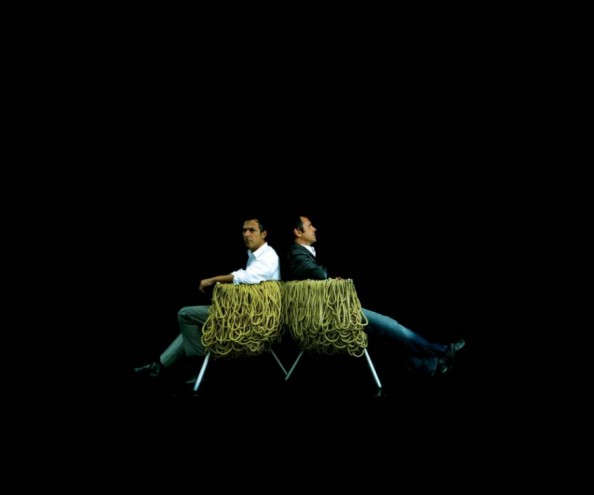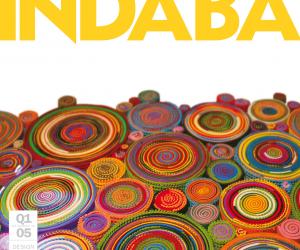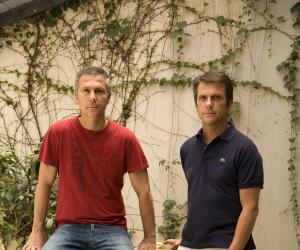First Published in
Drawing inspiration from the street life and artisanal traditions of Brazil, the brothers Fernando and Humberto Campana combine found objects - such as scraps of wood, plastic hose, stuffed toys and scraps of fabric - with advanced technologies to define a vibrant, energetic and definitively Brazilian approach to design.
By transforming their modest materials, the Campanas celebrate the discarded and mundane in work instilled with the spirit of contemporary Brazil that they describe as "zest for life".
Neither brother intended to be a designer. Humberto, born in the Rio Claro area of Sao Paulo in 1953, originally studied law. He began to design furniture in the mid-1980s after Fernando, born in Brotas in 1961, came to work with him having completed a degree in architecture. Using a Sao Paulo garage as a makeshift studio, they taught themselves how to make furniture by experimenting with cheap materials and rudimentary techniques - all they could afford at the time.
The importance of materials remains central to their practice: as does the process of transforming them. The challenge, as the Campanas see it, is to transform something poor into something opulent and decadent like the scraps of wood they found on the street to build their intricate Favela chair. To create the Vermelha chair, the brothers tied, wove and knotted an abundance of brilliantly coloured cord through a metal frame to replicate a bundle of rope bought from a nearby market. For their Sushi chairs, inspired by the patchwork bedspreads in the Sao Paulo slums, they transformed strips of brightly coloured plastic and remnants of fabric, felt and carpet underlay into decorative rolls of upholstery.
Throughout their work, the Campanas draw heavily on the material tradition of Brazil, which is rooted in skilled craftsmanship and economy of means. Since the late 1990's when the Italian company Edra began to manufacture their furniture, the brothers have developed ways of adapting their idiosyncratic techniques for industrial production. Often they film the process of their objects being made by hand in Brazil to enable manufacturers to replicate it in their factories. By experimenting with high and low-tech materials and techniques, the Campanas are able to harness the energy of their inherited tradition while defining a new aesthetic based on experimentation and advanced technologies.
The brothers have also created a fresh and surprising way of looking at things, which presents a bold alternative to the European rationalism that has long dominated design.
When they began working as designers twenty years ago, Brazil was emerging from decades of dictatorship.
Their career has coincided with its cultural renaissance. By weaving the fabric of Brazil into their objects, Fernando and Humberto Campana present a very personal portrait of their country. "Brazil is our great fountain of inspiration," they say. "Everything inspires us: from the people and how they organise their lives, to geographical and ethnic variety. This fusion is what we truly consider to be modernity."
The Multidao and Banquete chairs
Like the stuffed lions, dogs and alligators in the Banquete series, the Multidao chair comes from an impulse to create a new form of upholstery using unconventional methods. The brothers sourced the traditional fabric dolls from a small town in the state of Paraiba in north-eastern Brazil. "What distinguishes our work is the scarcity of technical resources, which is also our treasure. Brazil is our great fountain of inspiration. Everything inspires us: from the people and how they organise their lives, to the geographic and ethnic variety. This fusion is what we truly consider to be modernity.
The Celia chair
Made from panels of compressed wood and coloured paper, the Celia chair was named after Fernando and Humberto's mother, who often complained that her sons had not named any of their work after her. It is one of the first chairs that the brothers developed to be manufactured for the Brazilian mass market.
The Favela chair
Inspired by the haphazard and chaotically built shanty towns of Sao Paulo, the Campanans designed a chair using similar construction techniques from scraps of wood they found on the streets. The result is an intricately fabricated chair, carefully assembled piece by piece using hundreds of components. There are two versions of the Favela Chair in this exhibition: the first is the original prototype and the second is the one manufactured by the Italian company Edra.
The Boa sofa
Coiled like a boa constrictor snake, this opulent sofa is made from a tangle of over 90 metres of stuffed velvet tubing on which several people can sit at once.
The Anemone chair
Like the earlier Jardim chair and the Zig Zag stool, the Anemone chair is composed of abundant lengths of PVC garden hose wrapped around a stainless steel frame to create a comfortable seat.
The Sushi series
Among the most versatile examples of the Campanas' experiments with found materials is the sushi series of chairs, sofas, stools, bowls and tables made with tightly rolled bundles of fabric off-cuts, remnants of carpets, scraps of rubber and underlay. In the favelas of Brazil, they make mats and bedspreads of all sorts simply by overlapping fabric remainders.
"We began with this poor tradition and we thought of Sushi. Textiles of different types, natural and artificial, felts, wools, carpets, rubber, all rolled together and pushed into a tube of elasticised cloth."
The Corallo
The Campanas describe the Corallo as a three-dimensional scribble in painted steel wire. The irregular woven form is shaped by hand to resemble the sprawling coral reefs found off the coast of Brazil.
Vermelha chair
Inspired by a big bunch of rope that the brothers bought on a Sao Paulo street market, the Vermelha chair consists of a steel frame draped with more than 450 metres of scarlet rope braided and woven in a complex system of ties and knots. The first version was made by hand in Brazil. When the Italian manufacturer Edra offered to put it into industrial production, the brother shot an instructional film on video to demonstrate how the rope should be tied. This marked the beginning of the Campanas' experiments with developing an approach to industrial production rooted in Brazilian craft tradition.
Drawing inspiration from the street life and artisanal traditions of Brazil, the brothers Fernando and Humberto Campana combine found objects - such as scraps of wood, plastic hose, stuffed toys and scraps of fabric - with advanced technologies to define a vibrant, energetic and definitively Brazilian approach to design.
By transforming their modest materials, the Campanas celebrate the discarded and mundane in work instilled with the spirit of contemporary Brazil that they describe as "zest for life".
Neither brother intended to be a designer. Humberto, born in the Rio Claro area of Sao Paulo in 1953, originally studied law. He began to design furniture in the mid-1980s after Fernando, born in Brotas in 1961, came to work with him having completed a degree in architecture. Using a Sao Paulo garage as a makeshift studio, they taught themselves how to make furniture by experimenting with cheap materials and rudimentary techniques - all they could afford at the time.
The importance of materials remains central to their practice: as does the process of transforming them. The challenge, as the Campanas see it, is to transform something poor into something opulent and decadent like the scraps of wood they found on the street to build their intricate Favela chair. To create the Vermelha chair, the brothers tied, wove and knotted an abundance of brilliantly coloured cord through a metal frame to replicate a bundle of rope bought from a nearby market. For their Sushi chairs, inspired by the patchwork bedspreads in the Sao Paulo slums, they transformed strips of brightly coloured plastic and remnants of fabric, felt and carpet underlay into decorative rolls of upholstery.
Throughout their work, the Campanas draw heavily on the material tradition of Brazil, which is rooted in skilled craftsmanship and economy of means. Since the late 1990's when the Italian company Edra began to manufacture their furniture, the brothers have developed ways of adapting their idiosyncratic techniques for industrial production. Often they film the process of their objects being made by hand in Brazil to enable manufacturers to replicate it in their factories. By experimenting with high and low-tech materials and techniques, the Campanas are able to harness the energy of their inherited tradition while defining a new aesthetic based on experimentation and advanced technologies.
The brothers have also created a fresh and surprising way of looking at things, which presents a bold alternative to the European rationalism that has long dominated design.
When they began working as designers twenty years ago, Brazil was emerging from decades of dictatorship.
Their career has coincided with its cultural renaissance. By weaving the fabric of Brazil into their objects, Fernando and Humberto Campana present a very personal portrait of their country. "Brazil is our great fountain of inspiration," they say. "Everything inspires us: from the people and how they organise their lives, to geographical and ethnic variety. This fusion is what we truly consider to be modernity."
The Multidao and Banquete chairs
Like the stuffed lions, dogs and alligators in the Banquete series, the Multidao chair comes from an impulse to create a new form of upholstery using unconventional methods. The brothers sourced the traditional fabric dolls from a small town in the state of Paraiba in north-eastern Brazil. "What distinguishes our work is the scarcity of technical resources, which is also our treasure. Brazil is our great fountain of inspiration. Everything inspires us: from the people and how they organise their lives, to the geographic and ethnic variety. This fusion is what we truly consider to be modernity.
The Celia chair
Made from panels of compressed wood and coloured paper, the Celia chair was named after Fernando and Humberto's mother, who often complained that her sons had not named any of their work after her. It is one of the first chairs that the brothers developed to be manufactured for the Brazilian mass market.
The Favela chair
Inspired by the haphazard and chaotically built shanty towns of Sao Paulo, the Campanans designed a chair using similar construction techniques from scraps of wood they found on the streets. The result is an intricately fabricated chair, carefully assembled piece by piece using hundreds of components. There are two versions of the Favela Chair in this exhibition: the first is the original prototype and the second is the one manufactured by the Italian company Edra.
The Boa sofa
Coiled like a boa constrictor snake, this opulent sofa is made from a tangle of over 90 metres of stuffed velvet tubing on which several people can sit at once.
The Anemone chair
Like the earlier Jardim chair and the Zig Zag stool, the Anemone chair is composed of abundant lengths of PVC garden hose wrapped around a stainless steel frame to create a comfortable seat.
The Sushi series
Among the most versatile examples of the Campanas' experiments with found materials is the sushi series of chairs, sofas, stools, bowls and tables made with tightly rolled bundles of fabric off-cuts, remnants of carpets, scraps of rubber and underlay. In the favelas of Brazil, they make mats and bedspreads of all sorts simply by overlapping fabric remainders.
"We began with this poor tradition and we thought of Sushi. Textiles of different types, natural and artificial, felts, wools, carpets, rubber, all rolled together and pushed into a tube of elasticised cloth."
The Corallo
The Campanas describe the Corallo as a three-dimensional scribble in painted steel wire. The irregular woven form is shaped by hand to resemble the sprawling coral reefs found off the coast of Brazil.
Vermelha chair
Inspired by a big bunch of rope that the brothers bought on a Sao Paulo street market, the Vermelha chair consists of a steel frame draped with more than 450 metres of scarlet rope braided and woven in a complex system of ties and knots. The first version was made by hand in Brazil. When the Italian manufacturer Edra offered to put it into industrial production, the brother shot an instructional film on video to demonstrate how the rope should be tied. This marked the beginning of the Campanas' experiments with developing an approach to industrial production rooted in Brazilian craft tradition.





















